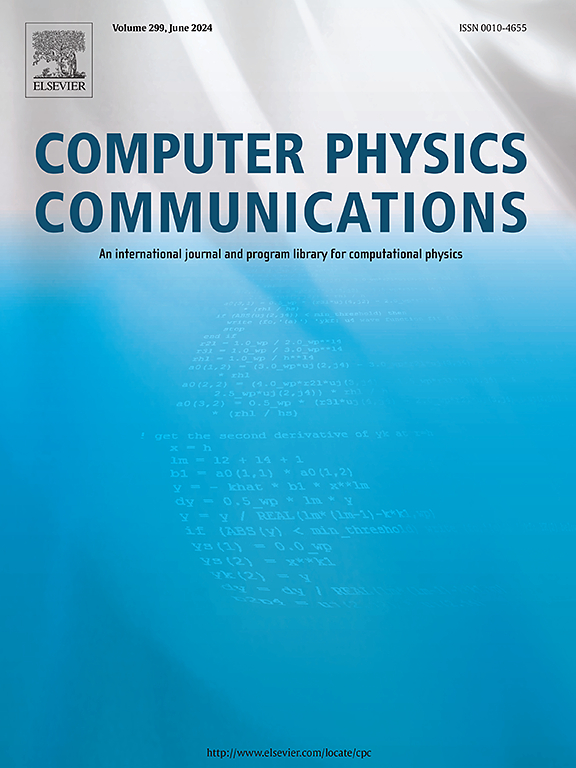qlbm – A quantum lattice Boltzmann software framework
IF 3.4
2区 物理与天体物理
Q1 COMPUTER SCIENCE, INTERDISCIPLINARY APPLICATIONS
引用次数: 0
Abstract
We present qlbm, a Python software package designed to facilitate the development, simulation, and analysis of Quantum Lattice Boltzmann Methods (QBMs). qlbm is a modular framework that introduces a quantum component abstraction hierarchy tailored to the implementation of novel QBMs. The framework interfaces with state-of-the-art quantum software infrastructure to enable efficient simulation and validation pipelines, and leverages novel execution and pre-processing techniques that significantly reduce the computational resources required to develop quantum circuits. We demonstrate the versatility of the software by showcasing multiple QBMs in 2D and 3D with complex boundary conditions, integrated within automated benchmarking utilities. Accompanying the source code are extensive test suites, thorough online documentation resources, analysis tools, visualization methods, and demos that aim to increase the accessibility of QBMs while encouraging reproducibility and collaboration.
Program summary
Program Title: qlbm
CPC Library link to program files: https://doi.org/10.17632/28hkvsg7p2.1
Developer's repository link: https://github.com/QCFD-Lab/qlbm
Licensing provisions: MPL-2.0
Programming language: Python3
Supplementary material: The documentation of is available at https://qcfd-lab.github.io/qlbm/.
Nature of problem: The advent of quantum algorithms for computational fluid dynamics brings with it challenges that are new to the established field of computational physics. These challenges include the lack of standardized implementations of the still nascent quantum methods, the intense computational demands of developing and simulating quantum algorithms on hardware available today, and the absence of tools that integrate novel developments into established infrastructure. Because of these current limitations, physicists and mathematicians expend superfluous resources on tasks that more mature computational physics branches have surmounted long ago.
Solution method: QLBM is a software package that provides an end-to-end development environment for quantum lattice Boltzmann methods. The modular design and flexible quantum circuit library provide a base for extending and generalizing quantum algorithms. Performance enhancements exploit the paradigm of quantum computing simulations to accelerate the speed at which researchers can verify the validity of their methods. Its integration with state-of-the-art quantum computing software and visualization tools increases the algorithms' accessibility. These features allow QLBM to effectively generate, simulate, and analyze quantum circuits for 2D and 3D computational fluid dynamics problems.
一个量子晶格玻尔兹曼软件框架
我们提出了qlbm,一个Python软件包,旨在促进量子晶格玻尔兹曼方法(qbm)的开发,模拟和分析。qlbm是一个模块化框架,它引入了为实现新型qbm量身定制的量子组件抽象层次结构。该框架与最先进的量子软件基础设施接口,以实现高效的模拟和验证管道,并利用新颖的执行和预处理技术,显着减少开发量子电路所需的计算资源。我们通过展示具有复杂边界条件的2D和3D多个qbm来展示该软件的多功能性,并集成在自动基准测试实用程序中。源代码附带了广泛的测试套件、完整的在线文档资源、分析工具、可视化方法,以及旨在增加qbm的可访问性,同时鼓励再现性和协作的演示。程序摘要程序标题:qlbmCPC库链接到程序文件:https://doi.org/10.17632/28hkvsg7p2.1Developer's存储库链接:https://github.com/QCFD-Lab/qlbmLicensing条款:mpl -2.0编程语言:python3补充材料:的文档可在https://qcfd-lab.github.io/qlbm/.Nature的问题:量子算法的出现为计算流体动力学带来了新的挑战,以建立计算物理领域。这些挑战包括缺乏对尚处于萌芽阶段的量子方法的标准化实现,在现有硬件上开发和模拟量子算法的巨大计算需求,以及缺乏将新开发集成到现有基础设施中的工具。由于目前的这些限制,物理学家和数学家花费了多余的资源来完成更成熟的计算物理分支早已超越的任务。解决方法:QLBM是一个软件包,为量子晶格玻尔兹曼方法提供端到端的开发环境。模块化设计和灵活的量子电路库为量子算法的扩展和推广提供了基础。性能增强利用量子计算模拟的范例来加快研究人员验证其方法有效性的速度。它与最先进的量子计算软件和可视化工具的集成增加了算法的可访问性。这些功能使QLBM能够有效地生成,模拟和分析二维和三维计算流体动力学问题的量子电路。
本文章由计算机程序翻译,如有差异,请以英文原文为准。
求助全文
约1分钟内获得全文
求助全文
来源期刊

Computer Physics Communications
物理-计算机:跨学科应用
CiteScore
12.10
自引率
3.20%
发文量
287
审稿时长
5.3 months
期刊介绍:
The focus of CPC is on contemporary computational methods and techniques and their implementation, the effectiveness of which will normally be evidenced by the author(s) within the context of a substantive problem in physics. Within this setting CPC publishes two types of paper.
Computer Programs in Physics (CPiP)
These papers describe significant computer programs to be archived in the CPC Program Library which is held in the Mendeley Data repository. The submitted software must be covered by an approved open source licence. Papers and associated computer programs that address a problem of contemporary interest in physics that cannot be solved by current software are particularly encouraged.
Computational Physics Papers (CP)
These are research papers in, but are not limited to, the following themes across computational physics and related disciplines.
mathematical and numerical methods and algorithms;
computational models including those associated with the design, control and analysis of experiments; and
algebraic computation.
Each will normally include software implementation and performance details. The software implementation should, ideally, be available via GitHub, Zenodo or an institutional repository.In addition, research papers on the impact of advanced computer architecture and special purpose computers on computing in the physical sciences and software topics related to, and of importance in, the physical sciences may be considered.
 求助内容:
求助内容: 应助结果提醒方式:
应助结果提醒方式:


